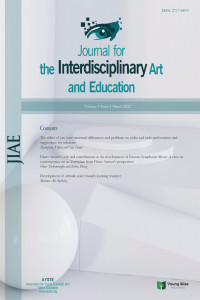Freedom of learning in the "elementary arts and culture" subject the character-based covid-19 pandemic
Freedom of learning in the "elementary arts and culture" subject the character-based covid-19 pandemic
The purpose of this study is to find the author's experience data during the Covid-19 pandemic season 2020 in Indonesia, the ability of students in the academic field and online on the character-based Elementary Arts Learning course, highly visible from the lecture process taking place during the Covid-19 pandemic from February 2020, and can find out the advantages of online learning found with maximum data and run according to RPS achievements. This study uses a qualitative approach to the research subject of Elementary School Teacher Education students, Teacher Training Faculty of Education. The results of the study show that the plague that currently enters into our beloved country in Indonesia has a significant impact on the level of the University of Muhammadyah Malang. This is the importance of the role of Education in Indonesia, especially in the Primary School Teacher Education Study Program, Faculty of Teacher Training in Education at the University of Muhammadyah Malang referring to Circular Letter Number 2 of 2020 concerning Prevention and Handling of Covid-19 in the Ministry of Education and Culture and Circular Letter Number 3 of 2020 concerning Prevention of Covid- 19 on the Education Unit. Teaching and learning process at home can use applications such as Edmudo, google classroom, as a medium for teaching and learning, WA, and Zoom media. The existence of an educational youtube video on Elementary Arts Learning and Culture can also be used as a process of deepening the material and the Approach to the Model of learning Teaching by heart, teaching with Empathy, Teaching with communication and positive politeness such as Problem Solving, and or evaluating to be an additional attraction for students to be motivated in learn.
Keywords:
Art and Culture, Character, Learning Freedom,
___
- Al-Yahyai, F. (2017). The Significance of Museums to Fine Art Education in Oman. Art and Design Review, 05(03), 189–199. https://doi.org/10.4236/adr.2017.53015
- Aprotosoaie-Iftimi, A. M. (2019). The Degree of Openness of Undergraduate Education to Contemporary Art. Psychology, 10(08), 1125–1142. https://doi.org/10.4236/psych.2019.108073
- Arina, R. (2015). Psikologi Pendidikan Teori & Aplikasi. Malang: Universitas Muhammadiyah Malang.
- Bates, A. W., & Bates, T. (2005). Technology, e-learning and distance education. Psychology Press.
- Bekci, İ., Karataş, A. P. Ö. N., Kiymik, A. P. H., & Bitlisli, A. P. F. (N.D.). The Comparison Of Accounting Education Given In Turkey And In The Usa: Case Of Marmara University And The University Of Texas1.
- Cetin, Z., & Danacı, M. Ö. (2015). The Effect of Art Education on the Selective Attention Skills and Development of Preschoolers at 4—5 Years. Creative Education, 06(21), 2250–2255. https://doi.org/10.4236/ce.2015.621232
- Chapman, S. N. (2015). Arts immersion: Using the arts as a language across the primary school curriculum. Australian Journal of Teacher Education, 40(9), 5.
- Chick, R. C., Clifton, G. T., Peace, K. M., Propper, B. W., Hale, D. F., Alseidi, A. A., & Vreeland, T. J. (2020). Using technology to maintain the education of residents during the COVID-19 pandemic. Journal of Surgical Education.
- Christensen, J., Elefant, C., Koshland, L., McFerran, K., Pethybridge, E., Ottarsdottir, U., Robertson, J., Quibell, T., Prokofiev, F., & Fullarton, A. (2009). Arts therapies in schools: Research and practice. Jessica Kingsley Publishers.
- Clark, R. C., & Mayer, R. E. (2016). E-learning and the science of instruction: Proven guidelines for consumers and designers of multimedia learning. John Wiley & Sons.
- Dinham, J. (2007). Delivering primary visual arts education: Where rhetoric meets reality. Australian Art Education, 30(1), 16.
- Ekowati, D. W., & Setyaningrum, R. W. (2014). Model Pembelajaran Pendidikan Karakter Pada Pembelajaran Tematik Di SD Muhammadiyah 9 Kota Malang. Jurnal Humanity, 8(1).
- Halitopo, M. (2020). Implementasi Merdeka Belajar dalam Buku Teks Bahasa Inggris untuk SMK. Seminar Nasional Pendidikan, 1(1).
- Hällgren, C. (2015). Art Blended Research and Children’s Gender Identity Making. Creative Education, 06(22), 2333–2350. https://doi.org/10.4236/ce.2015.622240
- Holt, D. (2013). Primary arts education: Contemporary issues. Routledge.
- Husamah, H., Restian, A., & Widodo, R. (2015). Pengantar Pendidikan. Research Report.
- Kalayci, S., & Coşkun, M. (2020). Determination of Gifted/Talented Students’ Interest in Science Subjects in Terms of Some Variables. Journal of Gifted Education and Creativity, 7(1), 1-9.
- McPherson, G. E. (1995). Integrating the arts into the general curriculum: An Australian perspective. Arts Education Policy Review, 97(1), 25–31.
- Murthy, S., Gomersall, C. D., & Fowler, R. A. (2020). Care for critically ill patients with COVID-19. Jama, 323(15), 1499–1500.
- Mustaghfiroh, S. (2020). Konsep “Merdeka Belajar” Perspektif Aliran Progresivisme John Dewey. Jurnal Studi Guru Dan Pembelajaran, 3(1), 141–147.
- Restian, A. (2010). Pola Pembelajaran Teknik Gerak Tari Beskalan Sebagai Materi Bahan Ajar Ekstrakurikuler. Di SMPN 6 Malang. SKRIPSI Jurusan Seni Dan Desain-Fakultas Sastra UM.
- Restian, A. (2016). Pelatihan Guru Seni Tari Tradisional SD Muhammadiyah 8 Dau Malang. Research Report, 315–321.
- Sag Sencal, E. (2020). The emergence and development of Saussurean linguistic thought and structural linguistics in Turkey. Language & History, 1–27.
- Selley, N. (2013). Art of constructivist teaching in the primary school: A guide for students and teachers. Routledge.
- Untari, M. F. A. (2014). Implementasi Pendekatan Saintifik (Scientific Approach) dalam Pembelajaran Di Sekolah Dasar. Seminar Nasional Implementasi Pembelajaran Tematik Dalam Mengoptimalisasi Kurikulum 2013.
- Wilson, G. B., MacDonald, R. A., Byrne, C., Ewing, S., & Sheridan, M. (2008). Dread and passion: Primary and secondary teachers’ views on teaching the arts. The Curriculum Journal, 19(1), 37–53.
- Yancy, C. W. (2020). COVID-19 and African Americans. Jama.
- Yayın Aralığı: Yılda 4 Sayı
- Başlangıç: 2020
- Yayıncı: Genç Bilge Yayıncılık
